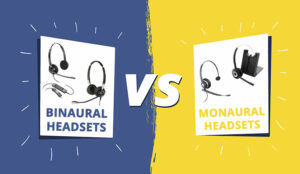The past couple of years have seen innovation in the headset market.
Paul Clark shares his thoughts with us…
Plugging the headset straight into the IP network
Some call centres have moved away from classic telephony to IP completely, providing advantages such as: free inter-office calls; on-screen dialling; the ability to route calls to a home office; integration with Microsoft Outlook; less downtime through multiple connectivity options and better accountability through call recording.
By moving away from classic telephony towards IP telephony, call centres can not only benefit from better, lower-cost capabilities but can further lower costs by eliminating the need for over-featured desk phones with largely redundant interfaces or the expensive PC upgrades required to run IP softphones.
Wireless headsets
Many companies are providing their sales teams with wireless headsets. This enables them to move away from having to sit at their desks and enables them to move around their cubicles and work area. This has led to developing better listening skills and improved empathy – both of which help with the conversion rate.
Snazzy design
Businesses have started to marry design, not only with practicality, but also with fashion and interoperability – taking into account the way people interact with it.
Headset design takes into account human behaviour, anatomy, ergonomics, colour, proportion and surface development, the aim being not only to make technology practical, but also to enable the design of advanced products that look beautiful and become extensions of the body. Ultimately, by making technology look stylish and smart, businesses are encouraging people to use it.
Wideband voice quality
Wideband is one of the more important factors and is the equivalent of HDTV, but for audio. Traditional telephony is based on sampling the sound stream 8,000 times a second, and constraining the reproduction of the sound spectrum to the range between 200Hz on the low end to 3.3KHz on the high end—and fitting it into a 64Kbps bandwidth. With a wideband codec however, it doubles the sampling rate and more than doubles the width of the sound spectrum reproduced, from 50Hz to 7KHz. This adds significant depth and nuance to the transmitted sound—and it reduces the bandwidth requirement to 32Kbps.
Ultimately this means that there is much more bandwidth than is required to transfer the information, which provides better sound quality, as well as more secure communications and increased resistance to natural interference.
It is important to note, however, that wideband only works if the entire network including the device is wideband. If the network is not wideband then the benefits of wideband will not be possible.
Noise cancellation in busy call centres
In any environment, as well as wideband, the use of noise-cancelling technology to reduce background noise and ensure that agents are properly heard is recommended. In addition to this, there is also a range of audio processor options which can be implemented depending on the type of communications technology in play.
Audio processors
Audio processors, very basically, maintain a consistent volume level for incoming calls as well as change frequency response, adding more high frequency emphasis and giving a crisp, clear sound, leading to fewer errors and repeat calls. Audio processors with digital signal processing (DSP) technology can also help to reduce background and line noise, cleaning up any echo on VoIP calls and ensuring a natural sound for a quality conversation.
All of this contributes to factors spurring on rapid development and adoption of communication technologies designed to enable smarter ways of working for the contact centre, both in terms of how we service customers and how we manage people.

Paul Clark
Paul Clark is Managing Director of Plantronics (www.plantronics.com)
Author: Jo Robinson
Published On: 30th Sep 2009 - Last modified: 30th Jun 2017
Read more about - Technology, Headsets, Poly
















I am quite frustrated with the promise of noise cancellation headsets, but when you use them they do the same as my current headsets.
What really works?
As I understand it the big benefit of noise cancelling headsets is not for you, but the person on the other end of the line.
I tried yesterday running a noise cancelling headset on my iphone in the car. Most people that I spoke to had no idea that I was in a car.
To get the full benefit from a noise cancelling headset, you have to position the microphone 2 finger widths ahead and to the side of the mouth. The noise cancelling performance degrades as the microphone is moved away from this position.
It is worth trying that, to see if you then notice the difference.